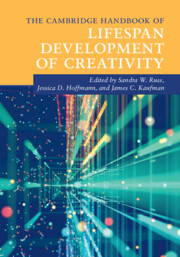Book contents
- The Cambridge Handbook of Lifespan Development of Creativity
- The Cambridge Handbook of Lifespan Development of Creativity
- Copyright page
- Dedication
- Contents
- Figures
- Tables
- Contributors
- Acknowledgments
- Introduction
- Part I Core Concepts of Lifespan Creativity Development
- 1 Basic Concepts of Creativity
- 2 The Creative Brain
- 3 Pretend Play
- 4 Creativity across the Lifespan
- Part II The Development of Creativity
- Part III Modes of Enhancement
- Part IV Environments and Contexts
- Part V Special Populations
- Index
- References
1 - Basic Concepts of Creativity
from Part I - Core Concepts of Lifespan Creativity Development
Published online by Cambridge University Press: 19 November 2021
- The Cambridge Handbook of Lifespan Development of Creativity
- The Cambridge Handbook of Lifespan Development of Creativity
- Copyright page
- Dedication
- Contents
- Figures
- Tables
- Contributors
- Acknowledgments
- Introduction
- Part I Core Concepts of Lifespan Creativity Development
- 1 Basic Concepts of Creativity
- 2 The Creative Brain
- 3 Pretend Play
- 4 Creativity across the Lifespan
- Part II The Development of Creativity
- Part III Modes of Enhancement
- Part IV Environments and Contexts
- Part V Special Populations
- Index
- References
Summary
In this chapter, we provide an overview of the basic concepts associated with creativity. This includes definitions as well as classic and contemporary models. Our approach to examining creativity theories is in line with the developmental theme of this book. We move through the progressive Four Cs model (mini, little, Pro, and Big) by elucidating each using appropriate theoretical conceptions. The Four Cs model and its representation of the creative trajectory over time, skill, practice, and expertise is crucial to our understanding of creativity across the lifespan. We conclude with placing creativity into a larger perspective that emerges from individual mental processes but thrives within overarching systems.
- Type
- Chapter
- Information
- Publisher: Cambridge University PressPrint publication year: 2021

